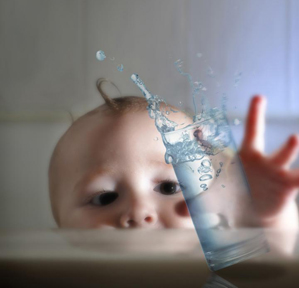|

Skin, important in regulating body temperature:
How climatic changes harm your skin
By Carol Aloysius
With weather patterns experiencing drastic changes today due to
global warming, the skin is the most vulnerable part of the body to be
affected by such extreme climatic changes.
|

You must nourish and take care of your body for your skin to be
at the optimal level of health. |
Hot moist weather which we are now experiencing in contrast to the
wet damp, cold weather can cause much damage to the skin apart from our
health. Such damage, if not treated early, can leave unsightly scars
that can remain for life.
Consultant Dermatologist, and Secretary, College of Dermatologists,
Dr INDIRA KAHAWITA speaks to the Sunday Observer on common skin ailments
that affect us, how they could be avoided and prevented and how they can
be treated.
Excerpts ...
Weather patterns have changed drastically in our country during the
past decade due to global warming. What are the effects of these changes
on one's skin?
The skin plays a very important role in regulating the body
temperature. Therefore a warm climatic condition will cause added stress
on the skin. In addition, the increasing effect of UV radiation due to
damage to the ozone layer also has some effects on the skin. This
manifests as photo-dermatitis (sun induced skin rashes), photoageing and
skin cancers, which we understand are long term effects.
Q. In the past three months we have experienced some very wet
and cold weather. How does such weather impact on one's skin?
A. Cold weather can predispose to drying of skin which gives
rise to eczemas and conditions like dandruff. Fungal infections become
common during wet weather conditions. Condition like athlete’s foot,
which occur due to excessive moisture are common during rainy weather.
Q. What can we do to protect our skin during a spell of cold
and rainy weather?
A. Regular use of moisturisers, trying to keep away from
moisture due to rain, drying of areas which are liable to retain
moisture (e.g. toe web spaces) and treatment of minor skin problems may
be of use.
Q. Most residents of up-country districts such as Nuwara Eliya
are forced to wear heavy warm clothing to ward off the cold. Can wearing
woolen jerseys, caps, stockings and socks and mittens all day and night
lead to skin ailments? If so, what kind of skin disorders?
A. Some persons develop allergy to woollen material, which may
present as itchy rashes in areas coming into contact with the woolen
clothing. In some persons fungal infections may occur in skin flexures
due to retained moisture.
Q. Can poor hygiene aggravate these disorders?
A. Yes, poor hygiene can aggravate infections. This can happen
as frequent bathing and washing may not be possible during extremely
cold spells.
Q. After the spell of rainy cold weather, we had in November
and December; we are now experiencing some very hot weather which is
causing us to sweat a great deal. What happens to the skin in such hot
moist weather?
A. When there is hot and moist weather with increased sweating
certain problems such as sweat rash and dandruff can get aggravated.
Fungal infections of the skin are also commoner during 'sweaty'
weather. Eczema is another condition which flares up during this type of
weather.
Another common problem is damage to skin due to excessive sun
exposure. It is very common in school children who have been in the sun
for the school sports-meet.
Q. How can these adverse effects be prevented?
A. The best type of prevention is keeping the skin as cool as
possible. You should pay special attention to using cotton clothing, use
of sun protection and regular washing/ bathing.
Use of fans or air conditioning may be use.
Q. What is the treatment you would recommend?
A. The treatment would depend on the condition.
Q. Where can it be obtained?
A. Most treatment including basic sun screens are available at
the skin clinics in government hospitals.
Q. Sores (hori) and blisters are also common skin disorders at
this time around. How are they caused?
A. Hori or scabies is due to a parasite (a microscopic mite)
but blisters could be due to sweat rash or a bacterial infection.
Q. Who are the high risk groups?
A. Children are the most high risk group for scabies and
bacterial blisters. Scabies can also occur in places where there is
overcrowding like prisons or refugee camps.
Q. How can they be prevented?
A. Good hygiene is the most important factor in prevention.
Regular bathing/ washing, using a mild shampoo or soap, use of clean
clothing and bed linen are very useful in prevention. But the most
important thing is to treat the infections effectively by following the
instructions of your doctor correctly.
In case of scabies it is important to treat the entire household.
Q. What about boils and abscesses?
A. Boils and abscesses are due to bacterial infections. They
are also common in children and people who have pre-existing medical
problems like diabetes
Q. Many adolescents often complain that the hot climate causes
them to break out with pimples. Apart from the hot weather, can this be
due to changes in their sex hormones? Your comments?
A. Acne may become aggravated during hot weather in some
persons. But the other causes are hormonal effects In some medications
like steroids, mental and physical stress and cosmetics and skin care
products can cause an outbreak of pimples.
Q. What is the danger of frequent touching, massaging,
breaking and squeezing pimples? Will it leave permanent scarring?
A. Touching and breaking pimples may lead to secondary
infection. But the most problematic thing is permanent scarring. If a
young person develops deep scars due to acne these scars are likely to
persist into adult life.
Q. Can they prevent or minimise the effects that hormonal
changes cause on their skin?
A. Rather than the hormonal effects the other risk factors can
be minimised or removed.
For instance, someone who has a tendency for acne should be very
careful in using cosmetics and skin care products. It is very important
to seek treatment for acne from a doctor at an early stage.
The treatment should be tailor-made for each individual. You may not
benefit from the same treatment that worked wonderfully for your friend
or sibling.
Talking about hormonal changes if there are any hormonal disorders
they should be treated.
Q. Another common skin infection in this part of the world is
Ring Worm infection. What is it? How is it caused? What are the
symptoms? Is it infectious?
A. Ring worm is a fungal infection of the superficial layers
of the skin.
The lesions are commoner in warm moist areas of the body like skin
flexures (armpits and groins).
They appear as itchy scaly lesions which heal in the centre and
spread outwards. It is infectious by touch (skin to skin) or through use
if infected clothing etc.
Q. What is the treatment? Can it be done at home?
A. The treatment is with anti fungal creams or tablets. This
can be done at home but the things to remember are the use of the
treatment for at least four weeks and to avoid re-infection by
disinfecting clothing and other material that come into contact with
skin.
Q. Eczema is another common skin disorder in Sri Lanka. What
is Eczema? How is it caused?
A. Eczema is an inflammatory condition of the skin.
This may occur as an allergic reaction to some material (contact
eczema due to rubber slippers) or due to genetic factors. When eczema is
due to genetic factors other conditions like asthma and hay fever may
also be associated. Whatever the cause, dry skin is a predisposing
factor for eczema.
Q. What is the treatment? Where is it available?
A. All skin clinics offer treatment for eczema. The treatment
should mostly be aimed at correcting the dry skin with regular
moisturisers.
Special soaps/lotions for dry skin may also help. Flare ups may be
treated with steroids (either creams/ointments or tablets) depending on
the severity.
Avoidance of aggravating factors, if identified, will also be
helpful.
Q. Can babies get it? What is the treatment for infantile
eczema?
A. Babies (from as early as three months) may develop eczema.
The principles of treatment are the same as for adult eczema.
It is important to minimise sweating and avoid contact with irritants
like soap, woolen material and urine.
Q. Whether it rains or sunny, schoolchildren are forced to
wear closed shoes with socks during school hours. Can this lead to them
developing skin ailments on their feet?
A. Wearing occlusive footwear can lead to increased sweating
and worsening of eczema.
This may be minimised by use of cotton socks and use of canvas shoes
rather than padded school shoes.
Q. What is athlete's foot? Is it caused by wearing closed
shoes and having damp skin in between your toes?
A. Yes, athlete’s foot is a fungal infection due to collection
of moisture between toes. It is commoner in people who wear shoes for
prolonged periods of time. Another cause is excessive moisture in the
toe web spaces.
Some people have less space between toes which is likely to cause
collections of moisture. Such people should take extra care to dry the
toe web spaces after a bath/ wash. Use of an anti fungal powder between
toes before wearing socks and shoes may help in preventing this.
Q. As a Dermatologist, what kind of skin disorders do you see
on the increase at present?
A. Eczemas are the commonest type of skin disorder seen in
skin clinics.
In addition fungal infections such as ringworm and aluham, and
bacterial infections like boils and abscesses and psoriasis are seen
commonly.
At present there is an increase in the number of people presenting
with problems related to the appearance like increased and decreased
pigmentation.
But this could be due to a better awareness about cosmetic problems
rather than an actual increase.
Q. Your message to children, adolescents and to the public in
general?
A. Skin diseases are common conditions that need to be treated
properly to achieve complete resolution. It is important to seek
treatment early.
Inform the doctor about the treatment you have received previously,
and if you can, show these medicines to the doctor.
Finally, follow the instructions carefully and continue the treatment
as long as the doctor instructs.
Weight loss and gain linked to increased fracture risk
Both weight gain and weight loss in older (postmenopausal) women are
associated with increased incidence of fracture, but at different
anatomical sites, finds a study published in The BMJ.
 The findings also challenge the traditional view that weight gain
protects against fractures. The findings also challenge the traditional view that weight gain
protects against fractures.
The influence of body weight on the risk of fracture is complex. Low
body weight is a well recognised risk factor for fracture, but obesity
also increases the risk of fracture at some sites. How fracture patterns
differ after intentional and unintentional weight loss in postmenopausal
women is also unknown.
So a team of US researchers investigated associations between
postmenopausal change in body weight and incidence of fracture - and
associations between voluntary and involuntary weight loss with risk of
fracture.
They analysed data on over 120,000 healthy postmenopausal women who
were taking part in the Women's Health Initiative Observational Study
and Clincial Trials. Women were aged 50-79 at the start of the study
(1993-98) and were followed for an average of 11 years.
Information such as age, ethnicity, body mass index (BMI), smoking,
alcohol intake, physical activity levels, calcium and vitamin D intake
was recorded at the start of the study.
Each year, participants were weighed and asked to report fractures of
the upper limb (hand, wrist, elbow, upper arm, shoulder), lower limb
(foot, knee, upper leg except hip, ankle), and central body (hip, pelvis
and spine). Change in body weight was categorised as stable (a change of
less than five percent from initial weight), weight loss (a decrease of
five percent or more since initial examination), and weight gain (an
increase of five percent or more since initial examination). Results at
the third annual visit show that, during an average of 11 years of
follow-up, compared with stable weight, weight loss was associated with
a 65 percent increase in hip fracture, a nine percent increase in upper
limb fracture, and a 30 percent increase in central body fracture. Also,
compared with women who had stable weight, weight gain was associated
with a 10% increase in upper limb fractures and an 18% increase in lower
limb fractures, but no difference in central body fractures. Compared
with stable weight, unintentional weight loss was associated with an
increased risk of hip and spine fractures, whereas intentional weight
loss was associated with an increased risk of lower limb fractures, but
a decreased risk of hip fractures.
This study is the first to focus specifically on how weight change
can differentially influence upper limb, lower limb, and central body
fractures among postmenopausal women in the US, say the authors. The
findings “have clinical and research implications and challenge the
traditional clinical paradigm of weight gain protecting against
fractures,” they add. “Clinicians should be aware that even intentional
weight loss is associated with increased rates of lower limb fractures.”
An accompanying editorial discusses the implications for clinical
practice. Juliet Compston, emeritus professor of bone medicine at
Cambridge University, says unintentional weight loss of five percent or
more in postmenopausal women “should be regarded as a risk factor for
fracture, particularly hip fracture.”
The finding of an increased risk of fracture with intentional weight
loss and with weight gain, albeit small, however, “emphasises the need
for measures to prevent bone loss during interventions to reduce
weight,” she said.
MNT
Researchers identify brain circuit regulating thirst
Scientists have identified a circuit in the brains of mice that
regulates thirst. When a subset of cells in the circuit is switched on,
mice immediately begin drinking water, even if they are fully hydrated.
A second set of cells suppresses the urge to drink.
 The thirst-regulating circuit is located in a region of the brain
called the subfornical organ (SFO). “We view the SFO as a dedicated
circuit that has two elements that likely interact with each other to
maintain the perfect balance, so you drink when you have to and you
don't drink when you don't need to,” says Charles Zuker, an HHMI
investigator at Columbia University who led the research. The thirst-regulating circuit is located in a region of the brain
called the subfornical organ (SFO). “We view the SFO as a dedicated
circuit that has two elements that likely interact with each other to
maintain the perfect balance, so you drink when you have to and you
don't drink when you don't need to,” says Charles Zuker, an HHMI
investigator at Columbia University who led the research.
By doing so, the circuit ensures animals take in the right amount of
fluid to maintain blood pressure, electrolyte balance, and cell volume.
Zuker's lab is primarily interested in the biology of taste.
Their studies have identified the receptors for the five basic tastes
(sweet, sour, bitter, uammi and salt) and shown that the nervous system
devotes multiple pathways to sensing and responding to salt.
These circuits ensure that salt is appealing to humans at low
concentrations, but not at high concentrations.
“This is how the taste system regulates salt intake, which is very
important for salt homoeostasis in the body,” says Oka.
“But this is just one side of the coin. Salt intake has to be
balanced by water intake.” The scientists knew a different mechanism
must be responsible for controlling an animal's water intake. “There are
no concentration changes for water - water is water,” Oka says. “But
when you're thirsty, water is really attractive.” Zuker and Oka set out
to determine how the brain regulated the motivation to drink. They began
their search in the brain region known as the SFO, which shows increased
activity in dehydrated animals. The SFO is one of the few regions of the
brain located outside the blood-brain barrier, meaning it has direct
contact with body fluids.
“These cells might then have the opportunity to directly sense
electrolyte balance in body fluids,” Zuker points out.
- MNT
|

